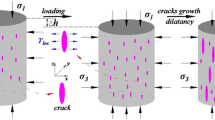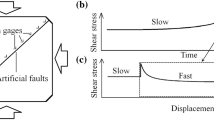Summary
A dilatancy model is presented which seems capable of simulating the results of laboratory tests on rock samples. The fundamental assumption incorporated in the model is that dilatancy is caused by the opening of cracks, where the cracks open in the least compressive stress direction (Brace et al., 1966). Its simplicity and compatibility with numerical techniques, involving the simulation of both static and dynamic stress fields, permits prediction of dilatancy induced effects for stress states and loading conditions which are not experimentally attainable.
Similar content being viewed by others
References
Y. P. Aggarwal, L. R. Sykes, J. Armbruster andM. L. Sbar,Premonitory changes in seismic velocities and prediction of earthquakes, Nature241 (1973), 101–104.
B. P. Bonner,Shear wave birefringence in dilating granite, Geophys. Res. Ltrs.1 (1974), 217–220.
W. F. Brace, B. W. Paulding, Jr. andC. Scholz,Dilatancy in the fracture of crystalline rocks J. Geophys. Res.71 (1966), 3939–3953.
W. F. Brace andD. K. Riley,Static uniaxial deformation of 15 rocks to 30 kbar, Int. J. Rock Mech. Min. Sci.9 (1972), 271–288.
C. G. Bufe, J. H. Pfluke andR. L. Wesson,Premonitory vertical migration of microearthquakes in central California—Evidence of dilatancy biasing?, Geophys. Res. Ltrs.1 (1974), 221–224.
I. G. Cameron,Theoretical model of the early phases of an underground explosion, Proceedings on Engineering with Nuclear Explosives1 (1970), 221–229.
I. G. Cameron andG. C. Scorgie,Dynamics of intense underground explosions, J. Inst. Maths. Applics.4 (1968), 194–222.
J. T. Cherry andF. L. Petersen,Numerical simulation of stress wave propagation from underground nuclear explosions, Proceedings on Engineering with Nuclear Explosions1 (1970), 142–220.
J. T. Cherry andT. C. Savage,Rock dilatancy and strain accumulation near Parkfield, California, Bull. Seism. Soc. Am.62 (1972), 1343–1347.
J. T. Cherry andR. N. Schock,A dilatancy model for Granodiorite, Lawrence Livermore Laboratory Report UCRL-72953 (1971).
J. T. Cherry, J. Sweet andE. J. Halda,Prediction of surface vertical and horizontal displacements in non-homogeneous media resulting from subsurface nuclear explosions, Systems, Science and Software Report, SSS-R-73-1517 (1973).
F. A. Dahlen,Elastic velocity anisotropy in the presence of an anisotropic initial stress, Bull. Seism. Soc. Am.62 (1972), 1183–1193.
I. N. Gupta,Dilatancy and premonitory variations of P, S travel times, Bull. Seism. Soc. Am.63 (1973), 1157–1161.
I. N. Gupta,Premonitory variations in S-Wave velocity anisotropy before earthquakes in Nevada, Science182 (1973), 1129–1132.
J. Handin, H. C. Heard andJ. N. Magouirk,Effects of the intermediate principal stress on the failure of limestone, dolomite and glass at different temperatures and strain rates, J. Geophys. Res.72 (1967), 611–640.
C. R. Hastings,Underground Test No. 4-Experiments to characterize 2-D damage for validation of Minuteman components, Project Officers Report, Systems, Science and Software Report SSS-CR-74-2318 (Draft). (S/RD) (1974).
H. C. Heard,The influence of environment on the inelastic behavior of rocks, Proceedings on Engineering With Nuclear Explosives1 (1970), 127–141.
R. Hill,The Mathematical Theory of Plasticity (Oxford 1950).
G. Maenchen andS. Sack,The TENSOR code, Methods in Computational Physics 3 (Academic Press, New York 1964).
K. Mogi,Effects of the intermediate principal stress on rock failure, J. Geophys. Res.72 (1967), 5117.
I. Nelson, M. L. Baron andI. Sandler,Mathematical models for geological materials for wavepropagation studies, inShock Waves and the Mechanical Properties of Solids, edited byJ. J. Burke andVolker Weiss (Syracuse University Press, Syracuse, New York 1971).
A. Nur,Dilatancy, pore fluids and premonitory variations of t s /t p travel times, Bull. Seism. Soc. Am.62 (1972), 1217–1222.
R. Robinson, R. L. Wesson andW. L. Ellsworth,Variation of P-wave velocity before the Bear Valley, California earthquake of 24 February 1972, Science184 (1974), 1281–1283.
R. N. Schock,Dynamic elastic moduli of rocks under pressure, Proceedings on Engineering with Nuclear Explosions1 (1970), 110–126.
R. N. Schock, H. C. Heard andD. R. Stephens,Stress-strain behavior of a granodiorite and two graywackes on compression to 20 kilobars, J. Geophys. Res.78 (1973), 5922–5941.
A. N. Semenov,Variations in the travel time of transverse and longitudinal waves before violent earthquakes, Izv., Earth Phys. No. 4 (1969), 72–77.
R. E. Thill,Acoustical methods of monitoring failure in rock, Proceedings of Fourteenth Symposium on Rock Mechanics, (1973), 649–688.
J. H. Whitcomb, J. D. Garmany andD. L. Anderson,Earthquake prediction: Variation of seismic velocities before the San Fernando earthquake, Science180 (1973), 632–635.
M. Wyss andD. J. Holcomb,Earthquake prediction based on station residuals, Nature249 (1973) 139–140.
Author information
Authors and Affiliations
Rights and permissions
About this article
Cite this article
Cherry, J.T., Schock, R.N. & Sweet, J. A theoretical model of the dilatant behavior of a brittle rock. PAGEOPH 113, 183–196 (1975). https://doi.org/10.1007/BF01592909
Received:
Issue Date:
DOI: https://doi.org/10.1007/BF01592909




